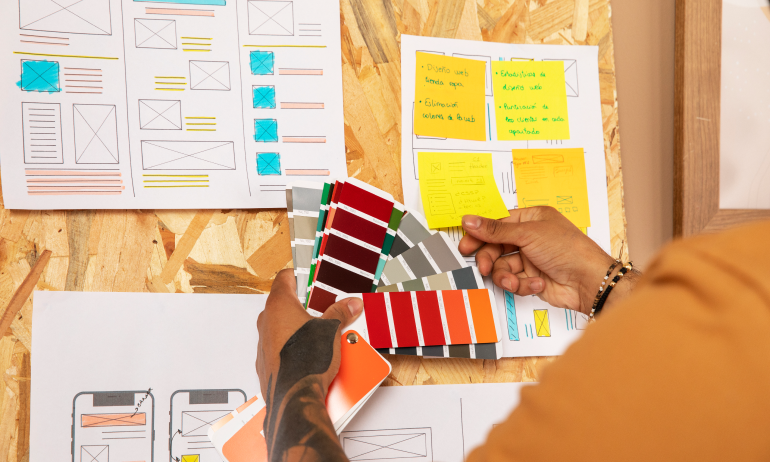Design is not a solo journey.
It’s a conversation—between the designer, the user, the team, and the client.
And the language of that conversation is feedback.
Great design isn’t just crafted—it’s refined, shaped by continuous input that helps uncover blind spots, validate ideas, and elevate user experience. But not all feedback is useful. Some is vague, late, or rooted in opinion rather than user value.
This blog breaks down how feedback, when structured and intentional, becomes your greatest design asset—not an obstacle.
🧠 Related read: How to Manage Client Expectations in Design Projects

Why Feedback Is Essential to Great Design
Design isn’t art. It’s problem-solving. And feedback ensures we’re solving the right problems.
Here’s why it’s so crucial:
📍 Catches blind spots early in the process
📍 Helps align the team with user goals, not personal preferences
📍 Reduces costly rework and delays
📍 Encourages collaboration and continuous improvement
📍 Builds trust between stakeholders and designers
Without feedback, you’re designing in a vacuum—and hoping for the best.
1. Types of Feedback in the Design Lifecycle
Feedback isn’t one-size-fits-all. It evolves as the design matures.
🔹 Initial Concept Feedback – Are we solving the right problem?
🔹 Wireframe Feedback – Is the structure usable and clear?
🔹 Visual Design Feedback – Do the aesthetics support the function?
🔹 Prototype Testing – Do users understand the flow and intent?
🔹 Client/Stakeholder Review – Does this align with goals and brand?
🧠 Bonus: Learn how to gather user-driven insights with our post on Effective User Research for Product Design
2. How to Collect Actionable Feedback (Not Just Opinions)
Feedback should be clear, focused, and aligned with design goals.
🎤 Ask better questions:
❌ “Do you like this?”
✅ “Does this layout help you find what you need quickly?”
❌ “Is this button okay?”
✅ “What do you expect to happen when you click this?”
📋 Use structured forms like:
✔️ Google Forms for async reviews
✔️ Loom videos for guided walkthroughs
✔️ FigJam/Notion boards for centralized comments
📌 Pro tip: Group feedback into themes—navigation, clarity, consistency, emotion—before acting on it.
3. Giving Feedback That Actually Helps Designers
Feedback isn’t helpful when it’s vague, emotional, or personal.
Here’s what good feedback sounds like:
🔹 Specific: “The text feels cramped on mobile”
🔹 Objective: “There’s no visual hierarchy between H1 and H2”
🔹 User-centered: “A new user might not understand this icon”
🔹 Constructive: “Could we test another layout that supports scanning?”
Avoid: “I don’t like it.” → Replace with: “This doesn’t match our brand tone. Could we explore a calmer palette?”
💬 Related read: How Great Design Enhances User Trust and Loyalty
4. Iteration: The Real Power of Feedback
A feedback loop is only useful if it drives iteration.
📈 Steps to apply it right:
✅ Prioritize feedback (not all notes are equally important)
✅ Discuss rather than blindly applying—especially when conflicting
✅ Make visible versioning (e.g. V1, V2.1)
✅ Test updated designs with users or internal team
✅ Document changes and rationale (Notion or Figma Notes work great)
Design is not a one-and-done—it’s version-controlled thinking.
5. Client Feedback: Balancing Vision and Value
Clients bring the business lens—but not always the user one. Your job? Bridge the gap.
🎯 Tips for smoother client feedback rounds:
🔸 Educate them early on the process and timeline
🔸 Present designs with clear context: goals, users, flows
🔸 Offer 2–3 options, not 10
🔸 Guide feedback by asking structured questions
🔸 Be open—but defend decisions with logic and research
🧠 Reference: The Importance of Time Management in Design Projects — Scope creep is avoidable with boundaries set during the feedback stage.
Real-World Example: How Feedback Saved a Design from Flopping
A SaaS platform was launching a new dashboard. The UI looked slick—but during feedback testing, users:
❌ Missed the key metrics at the top
❌ Confused the filter buttons with primary CTAs
❌ Overlooked the most important report link
Thanks to early user feedback, the team:
✅ Moved metrics to a hero card with contrast
✅ Used icons to differentiate filters from CTAs
✅ Added microcopy below critical links
📈 Result? A 2x increase in report views—and a 90% satisfaction score on post-launch surveys.
Feedback didn’t delay the design. It rescued it.
Mistakes to Avoid with Feedback in Design
🚫 Asking for feedback too late in the process
🚫 Taking feedback personally or becoming defensive
🚫 Overcorrecting based on one loud opinion
🚫 Not clarifying vague feedback before acting
🚫 Ignoring users in favor of internal preferences
Remember: Feedback is a tool—not a verdict.
Final Takeaway: Feedback is Your Design Co-Pilot
Feedback isn’t a roadblock—it’s the compass that keeps your design process aligned.
When done well:
✔️ It sparks collaboration, not conflict
✔️ It uncovers insights you can’t see alone
✔️ It transforms static designs into user-centric experiences
✔️ It builds products people understand, love, and trust
So invite it early. Welcome it often. And most of all—use it wisely.
💬 What’s Your Feedback Ritual?
Do you use weekly reviews? Loom walkthroughs? Client check-ins?
Share your feedback methods below 👇—and let’s improve together!




8 Comments
Oliver Mason
31 July 2025“Feedback is your co-pilot” 🛫🎯 — that’s going on my whiteboard!
Hannah Collins
31 July 2025Loved the “ask better questions” part — it’s a game-changer
Lily Harper
31 July 2025So true that vague feedback is the worst 😩 Specific = helpful!
James Taylor
31 July 2025This saved me from sending another “Do you like it?” email
Ava Bennett
31 July 2025Client feedback section was 🔥 More people need to read this!
Mason Blake
31 July 2025“Feedback rescued the design” 💯 Been there. Excellent example!
Henry Foster
31 July 2025Feedback is not a verdict — love that mindset
Scarlett Reed
31 July 2025Every designer needs to bookmark this 🖇️ Thank you for breaking it down so well!